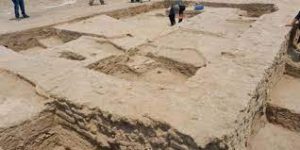14 May 2022 Rakhigarhi

Today Current Affairs
- The recent excavations of the Rakhigarhi site of the Harappan Civilization by the Archaeological Survey of India (ASI) have unearthed the structure of some houses, streets and drainage system.
- Thousands of pottery and seals have also been found in the excavation of ASI, besides copper and gold ornaments, terracotta toys.
- The purpose of this excavation is to locate the structural remains of Rakhigarhi and preserve them for future and make the archaeological site of Rakhigarhi accessible to tourists.
- Apart from this, DNA samples of two human skeletons found in the excavation have been collected and sent for scientific examination, on the basis of the test report of these DNA samples, about the genealogy and food habits of the people living in Rakhigarhi area thousands of years ago can be detected in.
Rakhigarhi – Today Current Affairs
- Rakhigarhi is the largest Harappan site in the Indian subcontinent.
- Other major sites of the Indus Valley Civilization (Harappan Civilization) in the Indian subcontinent are Harappa, Mohenjodaro and Ganveriwal in Pakistan and Dholavira (Gujarat) in India.
- Rakhigarhi is being excavated to trace the beginning of this civilization and to study its gradual development from 6000 BC (Pre-Harappan phase) to 2500 BC.
- The excavation work of this site was done under the leadership of Amarendra Nath of ASI.
- Rakhigarhi is one of the five iconic sites announced by the Union Finance Minister during the budget speech in the year 2020.
- Other such sites are Hastinapur in Uttar Pradesh, Sivasagar in Assam, Dholavira in Gujarat and Adichanallur in Tamil Nadu.
Key findings of the site:
COLONY : The Hindu Analysis
- Archaeological excavations show that the mature Harappan phase was represented by a planned city system with mud-brick as well as baked-brick houses with proper drainage.
Seals and pots : The Hindu Analysis
- A cylindrical seal, with five Harappan character figures on one side and a gharial on the other, is an important discovery from this site.
- The ceramic industry was represented by red pottery, which included simple saucers, vases, perforated jars.
Rituals and Cremations : The Hindu Analysis
- Archaeological excavations have also yielded evidence of mud-brick on the earthen floor and triangular and circular fire-altars with pits dug for animal sacrifice, indicating the ritual system of the Harappans.
- The excavation has also yielded some tombs, which certainly belong to a later phase, probably the medieval period.
- The excavation found two female skeletons buried with pottery and ornaments such as jasper, agate beads and shell bangles.
Other archaeological remains : The Hindu Analysis
- Blades, terracotta and shell bangles, semi-precious stone beads, copper objects, animal figurines, toy cart frame and terracotta wheel, engraved steatite seal and ceiling.
Study of DNA samples : The Hindu Analysis
- In a study done on DNA (DeoxyriboNucleic Acid) of skeletons excavated from the graveyard of Harappan site ‘Rakhigarhi’ in Haryana, it was found that the people of Indus Valley Civilization have an independent lineage.
- This study rejects the earlier hypothesis that the lineage of the Harappans was related to the steppe pastoralists or ancient Iranian farmers.


No Comments